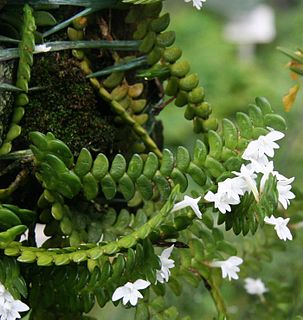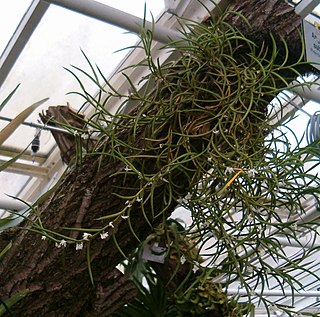
The genus Angraecum, abbreviated as Angcm in horticultural trade, common name Angrek or comet orchid, contains about 220 species.

The Sphingidae are a family of moths (Lepidoptera) called sphinx moths, also colloquially known as hawk moths, with many of their caterpillars known as “hornworms”; it includes about 1,450 species. It is best represented in the tropics, but species are found in every region. They are moderate to large in size and are distinguished among moths for their agile and sustained flying ability, similar enough to that of hummingbirds as to be reliably mistaken for them. Their narrow wings and streamlined abdomens are adaptations for rapid flight. The family was named by French zoologist Pierre André Latreille in 1802.
Angraecum pyriforme is a species of plant in the family Orchidaceae. It is found in western tropical Africa, to be precise in Cameroon, Ivory Coast, and Nigeria. Its natural habitat is subtropical or tropical moist montane forests. It is threatened by habitat loss.

Angraecum sanfordii is a species of plant in the family Orchidaceae. It is endemic to Cameroon, where it occurs on Mount Kupe and Mount Cameroon. It grows in submontane and montane habitat types. It is an epiphyte. It is threatened by habitat loss.

Angraecum sesquipedale, also known as Darwin's orchid, Christmas orchid, Star of Bethlehem orchid, and king of the angraecums, is an epiphytic orchid in the genus Angraecum endemic to Madagascar. The orchid was first discovered by the French botanist Louis-Marie Aubert du Petit-Thouars in 1798, but was not described until 1822. It is noteworthy for its long spur and its association with the naturalist Charles Darwin, who surmised that the flower was pollinated by a then undiscovered moth with a proboscis whose length was unprecedented at the time. His prediction had gone unverified until 21 years after his death, when the moth was discovered and his conjecture vindicated. The story of its postulated pollinator has come to be seen as one of the celebrated predictions of the theory of evolution.

Xanthopan is a monotypic genus of sphinx moth, with Xanthopan morganii, commonly called Morgan's sphinx moth, as its sole species. It is a very large sphinx moth from Southern Africa and Madagascar. Little is known about its biology, though the adults have been found to visit orchids and are one of the main pollinators of several of the Madagascar endemic baobab (Adansonia) species, including the critically endangered Adansonia perrieri or Perrier's baobab.

Aerangis luteoalba is a species of epiphytic orchid native to eastern and central Africa. This species includes 2 currently recognized varieties:

Angraecum distichum is a species of comet orchid that is found across sub-Saharan and tropical Africa. It can be found on Klainedoxa gabonensis, Gilbertiodendron dewevrei, Mangifera indica and in cocoa plantations. It can also occur with Calamus, Uapaca heudelotii and Irvingia smithii, and in the undergrowth with Marantaceae and Zingiberaceae.

Angraecum eburneum is a species of orchid. Their common name the "comet orchid". They generally grow up to 2 meters in height and grows 10 to 15 flowers per plant. They are native to Madagascar, Comoros, Seychelles, Réunion, Mauritius, Kenya, and Tanzania.

Angraecum scottianum is a species of orchid.

Angraecum viguieri is a species of orchid.

Angraecum cadetii is a species of orchid endemic to Mauritius and Réunion. It was named after botanist Thérésien Cadet. It is the only known flower known to be pollinated by a cricket, specifically by a species of raspy cricket: Glomeremus orchidophilus.

Angraecinae is a subtribe in the family Orchidaceae. The subtribe consists of approximately 18 genera and about 360 species. The type genus is Angraecum. Most of the genera are endemic to Africa, Madagascar and other Indian Ocean Islands, a few genera can also be found in the Americas.
Angraecum atlanticum is a species of comet orchid that can be found in Equatorial Guinea and Gabon. It is known from three subpopulations; in Monte Alén National Park in Equatorial Guinea and in Moukalaba-Doudou National Park and Ivindo National Park in Gabon. It is found in epiphyte-rich submontane forest, and in the shrubby fringes rich in Burseraceae.
Angraecum penzigianum is a species of comet orchid that is endemic to Madagascar, and is recorded from Antsiranana, Fianarantsoa and Toamasina provinces, from elevations of 1,000–2,000 m. It is an epiphytic perennial which grows in mossy forests. It was previously thought to be endemic to the Andringitra Massif. It is threatened by slash-and-burn cultivation, cattle grazing, charcoal production and bush fires.

Angraecum subulatum is a species of comet orchid that can be found in Cameroon, the Democratic Republic of the Congo, Côte d'Ivoire, Equatorial Guinea, Gabon, Ghana, Guinea, Liberia, Nigeria and Sierra Leone. This species is found in lowland forests, especially those rich in Caesalpinioideae between 50 and 700 m elevation. It occurs in periodically-inundated swampy forests with Raphia, Pandanus and Marantaceae, and on calcareous rock in shrubby vegetation. It has been recorded on high shaded branches of Gilbertiodendron dewevrei.
Gilbertiodendron dewevrei is a species of tree in the family Fabaceae, native to tropical rain forests in Central Africa. It is often the dominant tree species of the Guineo-Congolian rainforest. The timber is traded as limbali, and is used for construction, flooring and railway sleepers. It is also used for making boats, furniture, tool handles and joinery and for making charcoal.












